Uranium enrichment is a crucial process in the nuclear fuel cycle that increases the concentration of uranium-235, the isotope capable of sustaining a nuclear chain reaction 12. This process transforms natural uranium into a more potent form that can be used in nuclear reactors and, at higher enrichment levels, in nuclear weapons 34.
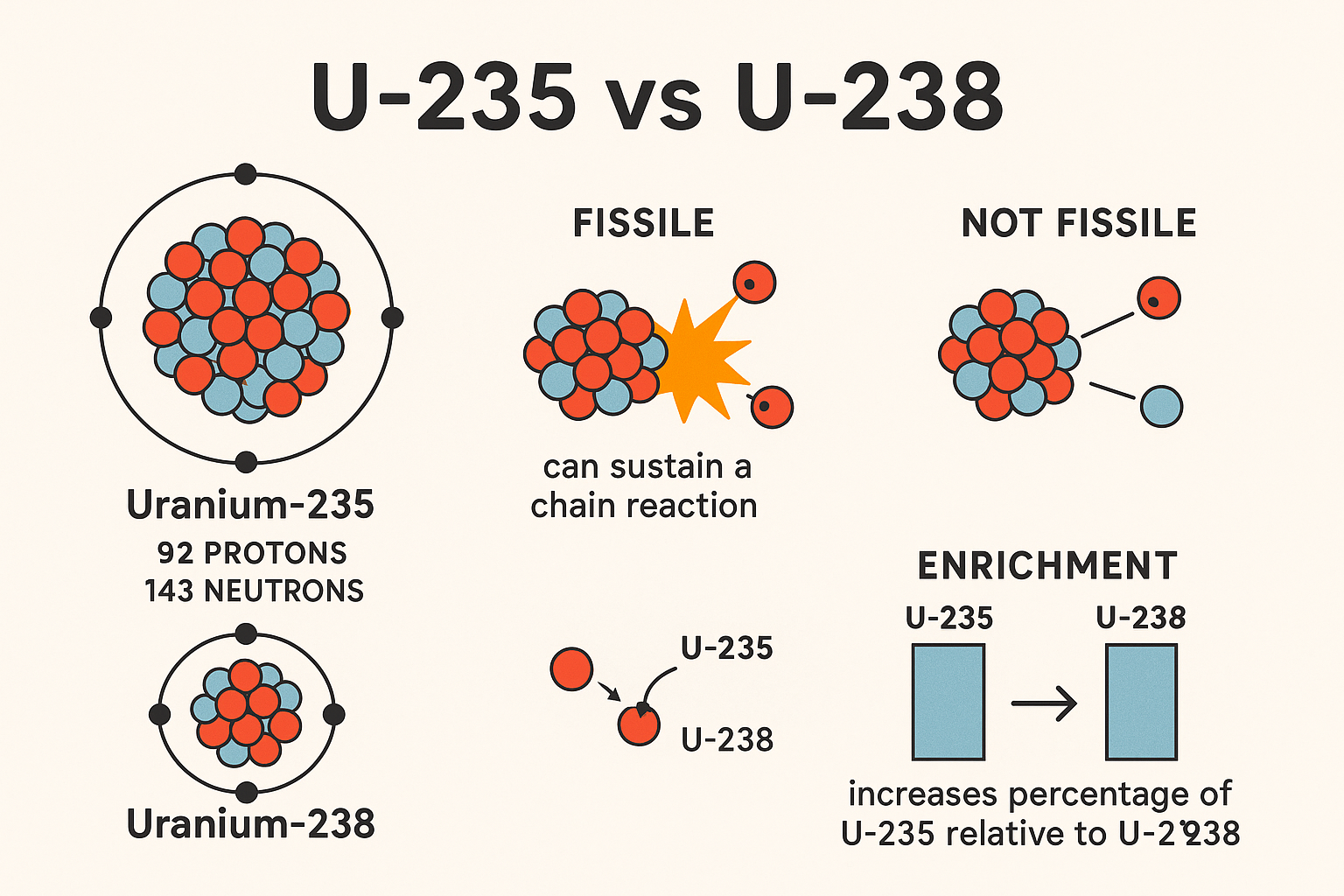
The difference between uranium isotopes and why enrichment matters
Understanding Uranium Isotopes
Uranium is a naturally occurring element found in rocks, soil, and water throughout the world 15. In its natural state, uranium consists primarily of two isotopes: uranium-238 (99.3%) and uranium-235 (0.7%) 67.
The key difference between these isotopes is the number of neutrons in their nuclei 82. Both have 92 protons (which defines them as uranium), but U-235 has 143 neutrons while U-238 has 146 neutrons 89.
This seemingly small difference is crucial because U-235 is fissile, meaning it can sustain a nuclear chain reaction when bombarded with neutrons 15. U-238, despite being much more abundant, cannot sustain such a reaction 28.

Natural abundance of uranium isotopes in nature
Why Enrichment Is Necessary
Most nuclear power reactors require uranium fuel with a higher concentration of U-235 than naturally occurs 27. While natural uranium contains only 0.7% U-235, commercial nuclear reactors typically need fuel with 3-5% U-235 51.
Without enrichment, nuclear energy as we know it would not be possible 45. The process allows us to concentrate the rare but valuable U-235 isotope to levels where it can efficiently produce energy 17.
The Uranium Fuel Cycle
Uranium enrichment is one part of a larger process called the nuclear fuel cycle 52. This cycle includes mining uranium ore, processing it into yellowcake, converting it to uranium hexafluoride gas, enriching it, and finally fabricating it into fuel pellets 125.

Diagram of the nuclear fuel cycle, illustrating the key stages from mining to spent fuel disposition, including uranium enrichment.
From Mine to Enrichment: The First Steps
The journey begins with uranium mining, where ore containing uranium is extracted from the earth 56. This ore typically contains only a small percentage of uranium 15.
After mining, the ore undergoes milling to produce a concentrated uranium powder known as “yellowcake” 12. This bright yellow substance (uranium oxide, U₃O₈) contains about 80% uranium 35.

Yellowcake, a uranium concentrate, shown in powder form and packaged, serves as a key precursor to uranium enrichment.
The yellowcake must then be converted to uranium hexafluoride (UF₆), a chemical form that becomes gaseous when heated 25. This gaseous state is essential for the enrichment process 17.
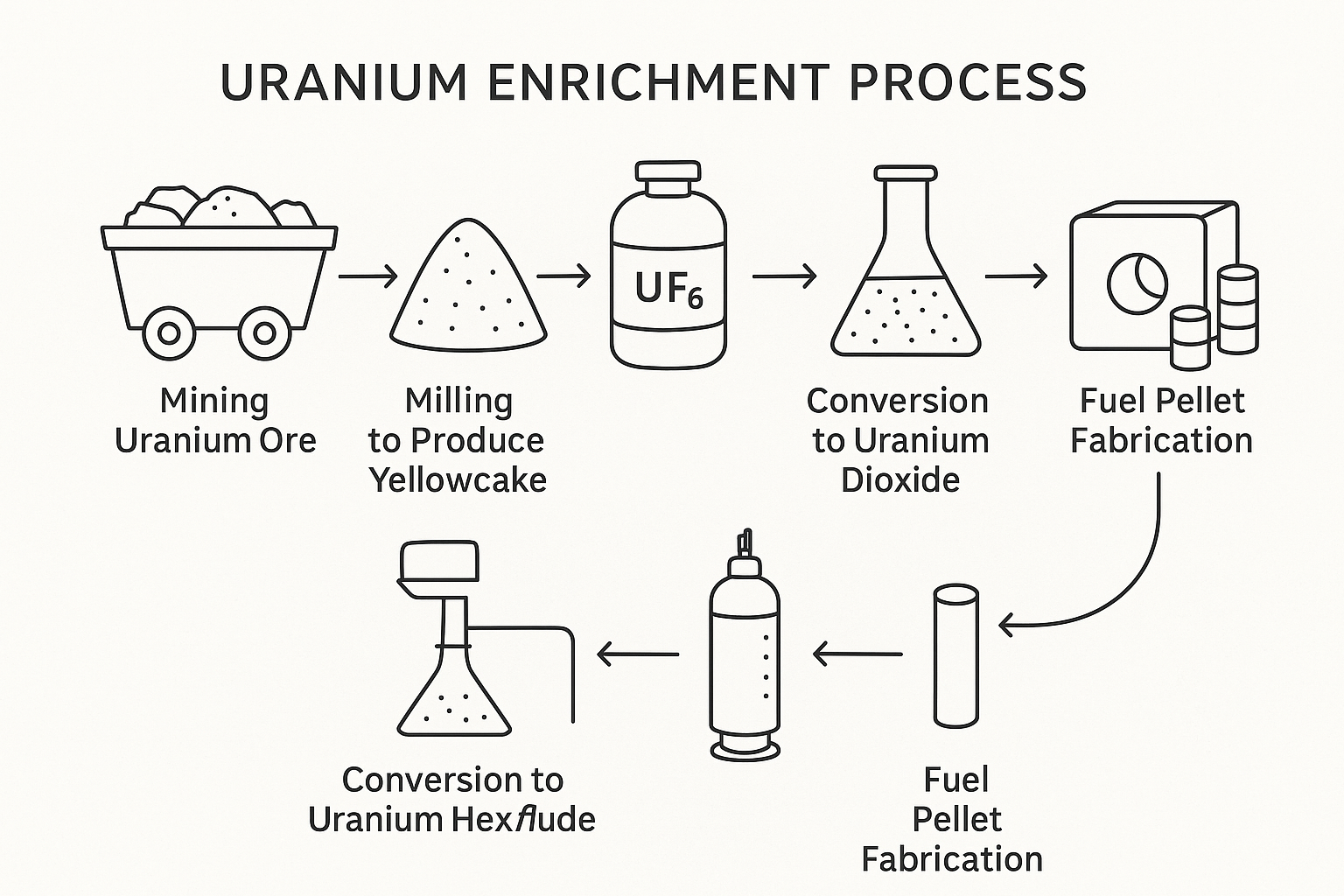
Flowchart showing the uranium enrichment process from ore to nuclear fuel
Enrichment Methods Explained
Several methods have been developed to enrich uranium, each using different physical principles to separate the isotopes 210. The three main techniques are gaseous diffusion, gas centrifuge, and laser enrichment 211.
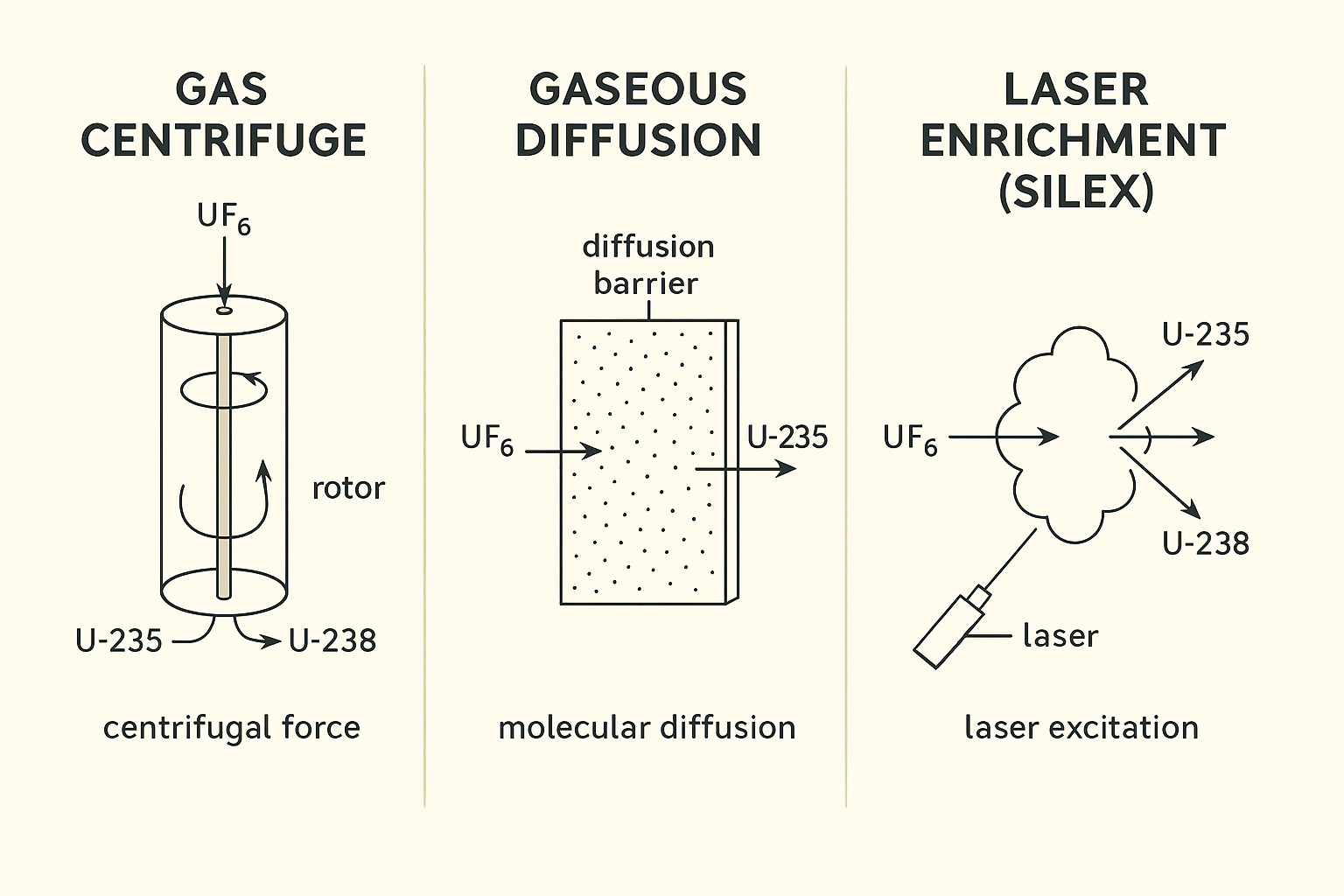
Comparison of three uranium enrichment methods: gas centrifuge, gaseous diffusion, and laser enrichment
Gaseous Diffusion
Gaseous diffusion was the first commercial enrichment method, widely used from the 1940s through the early 2000s 124. It relies on the principle that lighter molecules (containing U-235) move slightly faster than heavier ones (containing U-238) 212.
In this process, uranium hexafluoride gas is forced through semi-permeable membranes 122. The lighter U-235 molecules pass through the barriers slightly more easily than the heavier U-238 molecules 412.
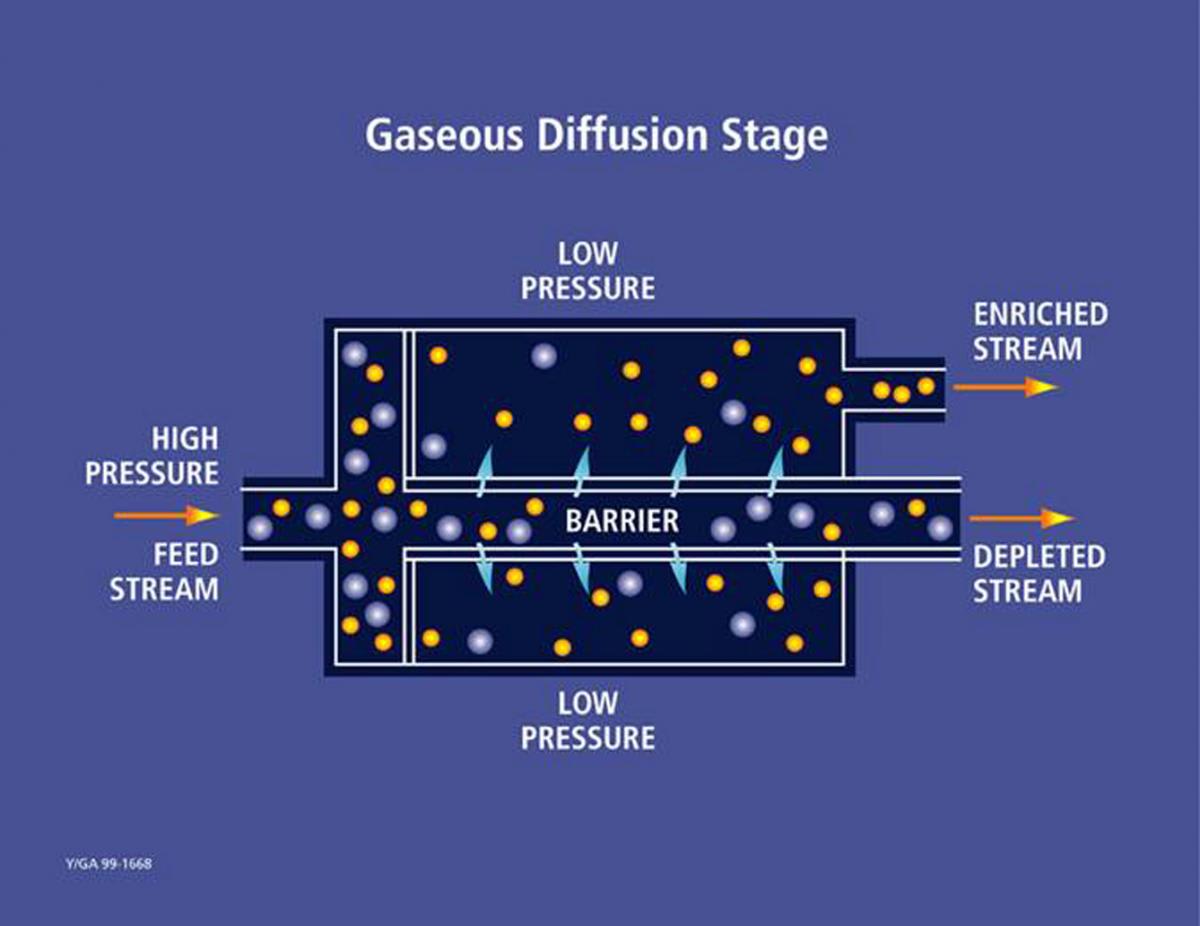
Diagram illustrating a single stage of the gaseous diffusion process for isotope separation.
This creates a small enrichment effect in each stage, requiring thousands of stages in sequence to achieve useful enrichment levels 122. Gaseous diffusion is extremely energy-intensive, requiring about 2,500 kWh per separative work unit (SWU) 212.
Gas Centrifuge
Gas centrifuge technology has largely replaced gaseous diffusion as the dominant enrichment method today 12. This method uses rapidly spinning cylinders to separate the uranium isotopes based on their slight mass difference 211.
When uranium hexafluoride gas is spun at extremely high speeds (up to 70,000 rpm), centrifugal force pushes the heavier U-238 molecules toward the outer wall while the lighter U-235 molecules concentrate toward the center 112.
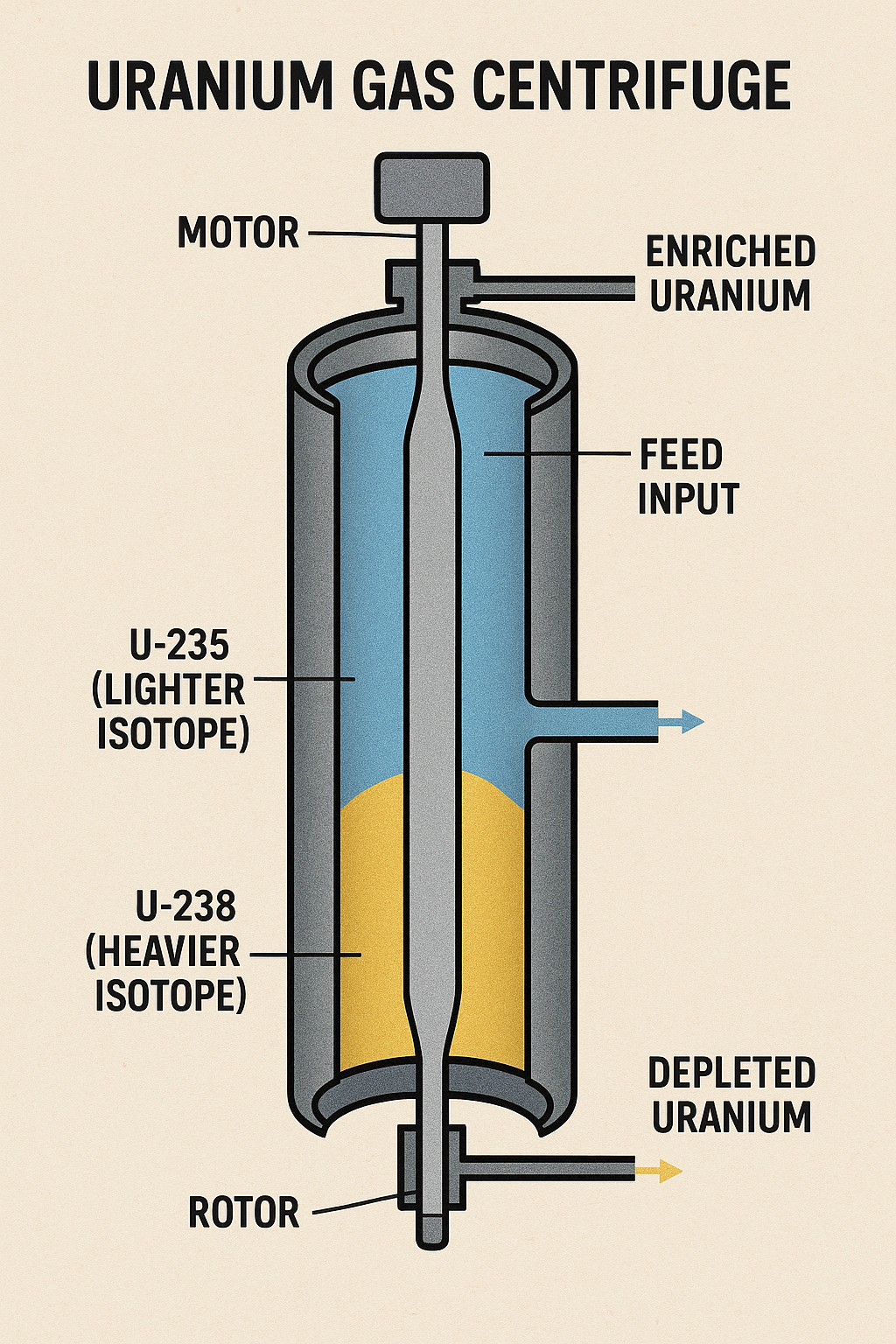
Cross-section diagram of a gas centrifuge showing how uranium isotopes are separated
Gas centrifuges are arranged in “cascades” where the enriched product from one centrifuge feeds into the next, gradually increasing the concentration of U-235 211. This method is much more energy-efficient than gaseous diffusion, using only about 50 kWh per SWU 212.
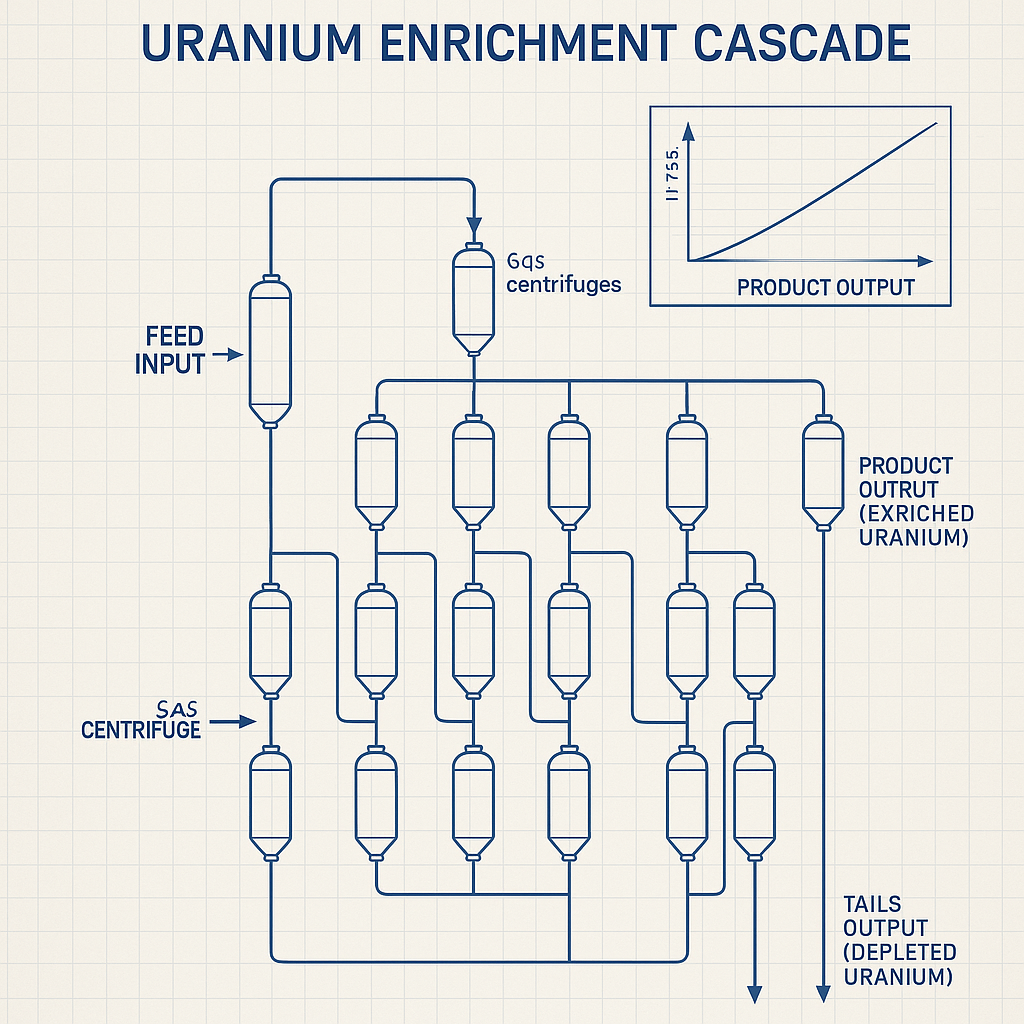
Gas centrifuge cascade system for uranium enrichment

Rows of gas centrifuges in a uranium enrichment facility.
Laser Enrichment
Laser enrichment represents the cutting edge of uranium enrichment technology 210. This method uses precisely tuned lasers to selectively excite and ionize U-235 atoms or molecules, allowing them to be separated from U-238 213.
While still under development for commercial use, laser enrichment promises even greater efficiency than centrifuge technology 1013. It may require as little as 100 kWh per SWU and could potentially achieve enrichment in fewer steps 1310.
Enrichment Levels and Applications
The level of enrichment determines how uranium can be used 314. Different applications require different concentrations of U-235 714.
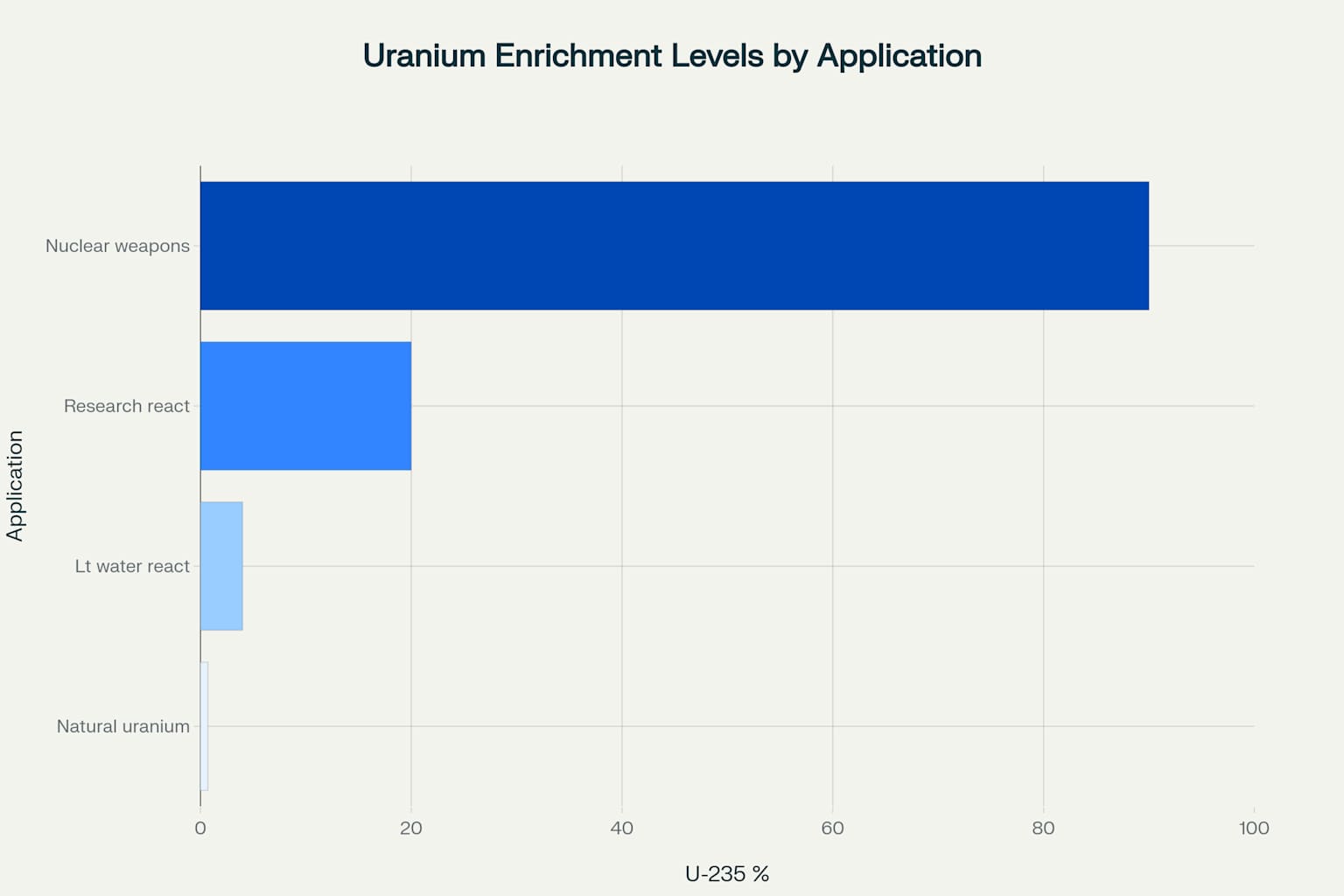
Uranium enrichment levels required for different applications
Low-Enriched Uranium (LEU)
Low-enriched uranium contains between 0.7% and 20% U-235, with most commercial power reactor fuel enriched to 3-5% 114. This level is sufficient for electricity generation but cannot be used for weapons 1415.
High-Assay Low-Enriched Uranium (HALEU)
HALEU contains between 5% and 20% U-235 and is being developed for use in advanced reactor designs 1617. It offers advantages like longer fuel cycles and more compact reactor designs 165.
Highly Enriched Uranium (HEU)
Uranium enriched above 20% U-235 is classified as highly enriched 1418. At levels above 90%, it becomes “weapons-grade” uranium suitable for nuclear weapons 1415. HEU is also used in naval propulsion and some research reactors 1914.
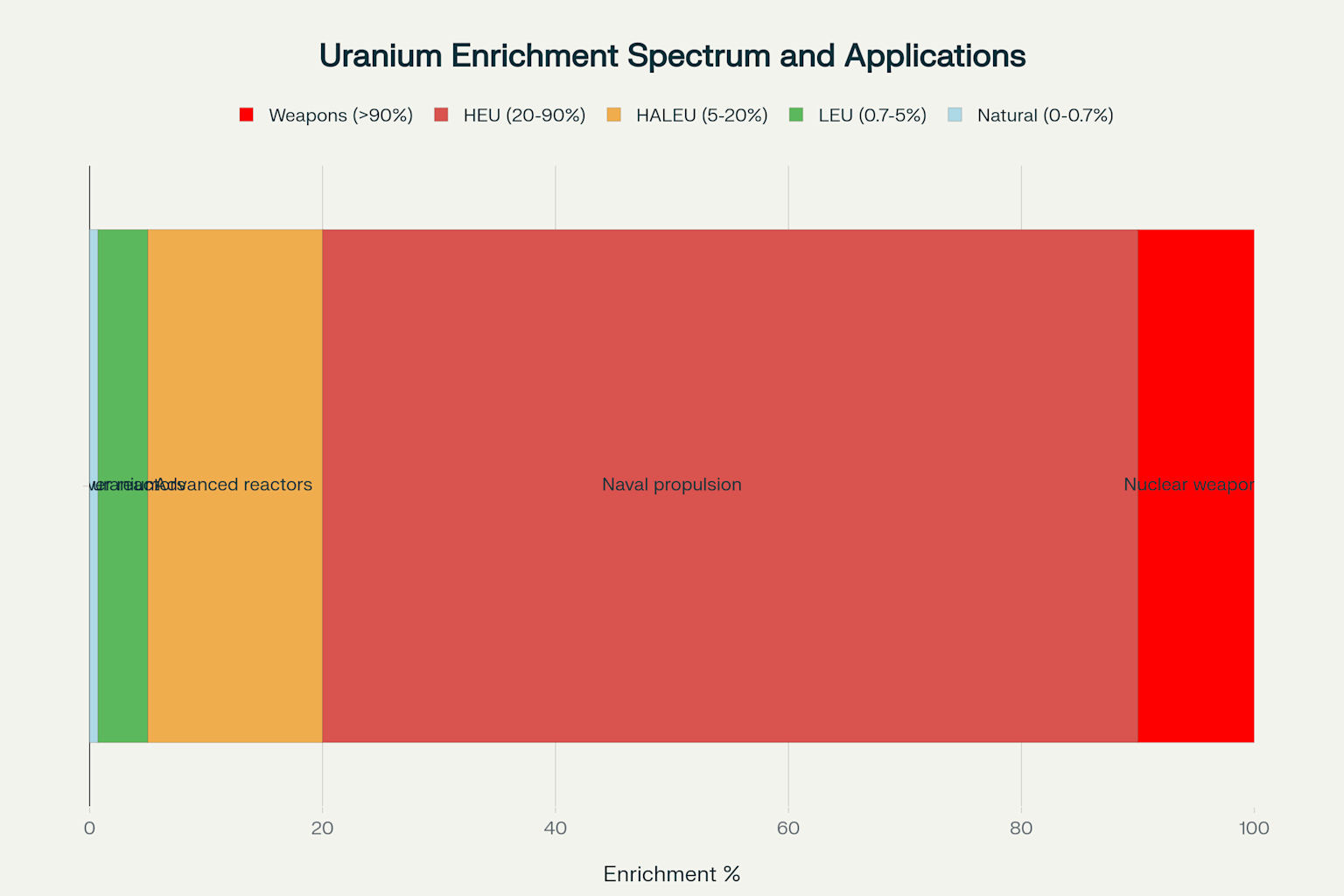
Uranium-235 enrichment spectrum and applications
The Energy Efficiency of Enrichment
The energy required for enrichment varies dramatically between methods 210. Modern gas centrifuge technology uses about 50 times less energy than the older gaseous diffusion process 212.
This efficiency difference has significant economic and environmental implications 122. Newer technologies like laser enrichment could further reduce energy consumption 1013.
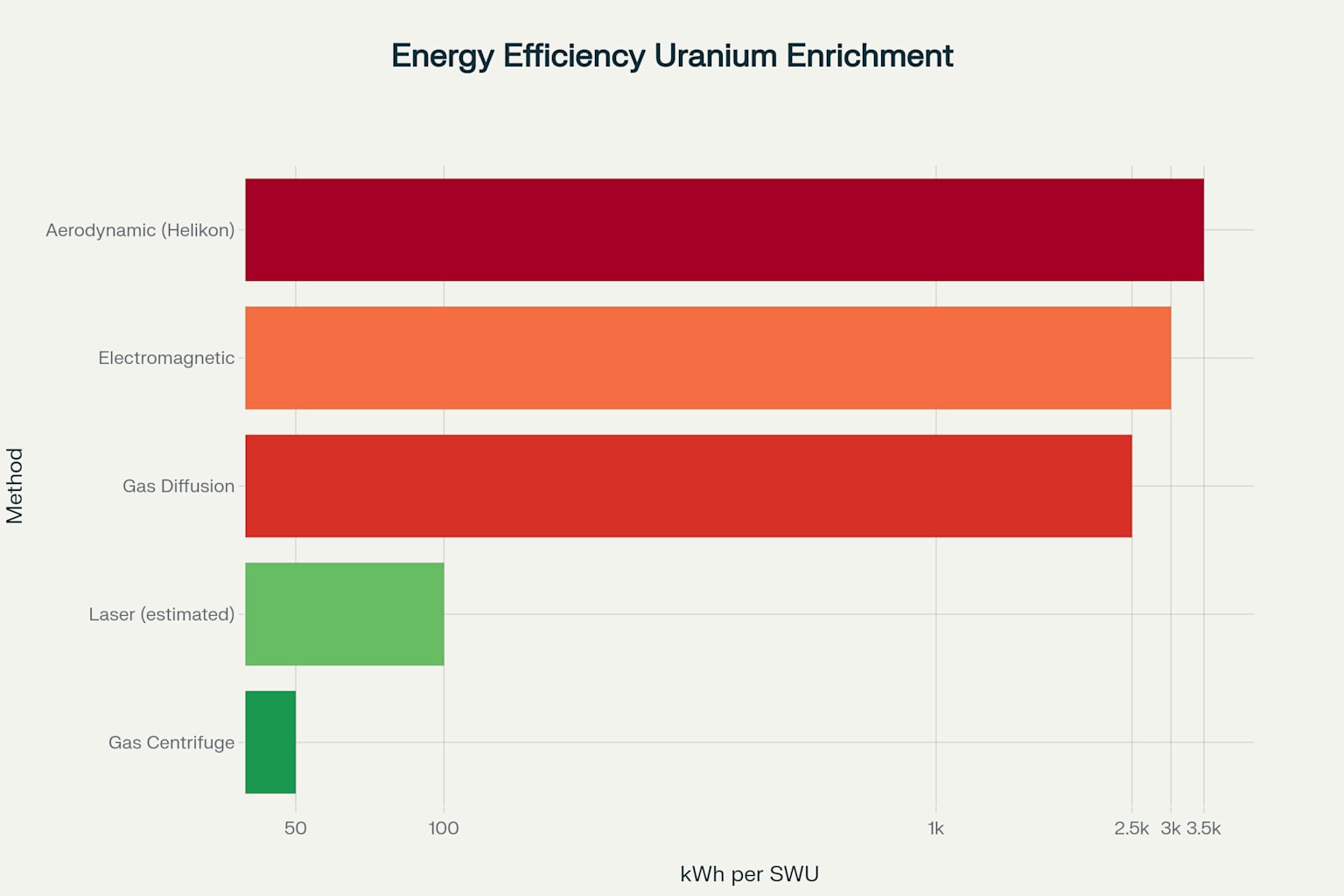
Energy consumption comparison of uranium enrichment technologies (kWh per SWU)
Global Enrichment Landscape
Uranium enrichment is conducted in relatively few countries due to its technical complexity and the dual-use nature of the technology 2021. Major commercial enrichment facilities are located in Russia, China, France, the United States, the United Kingdom, Germany, and the Netherlands 2120.
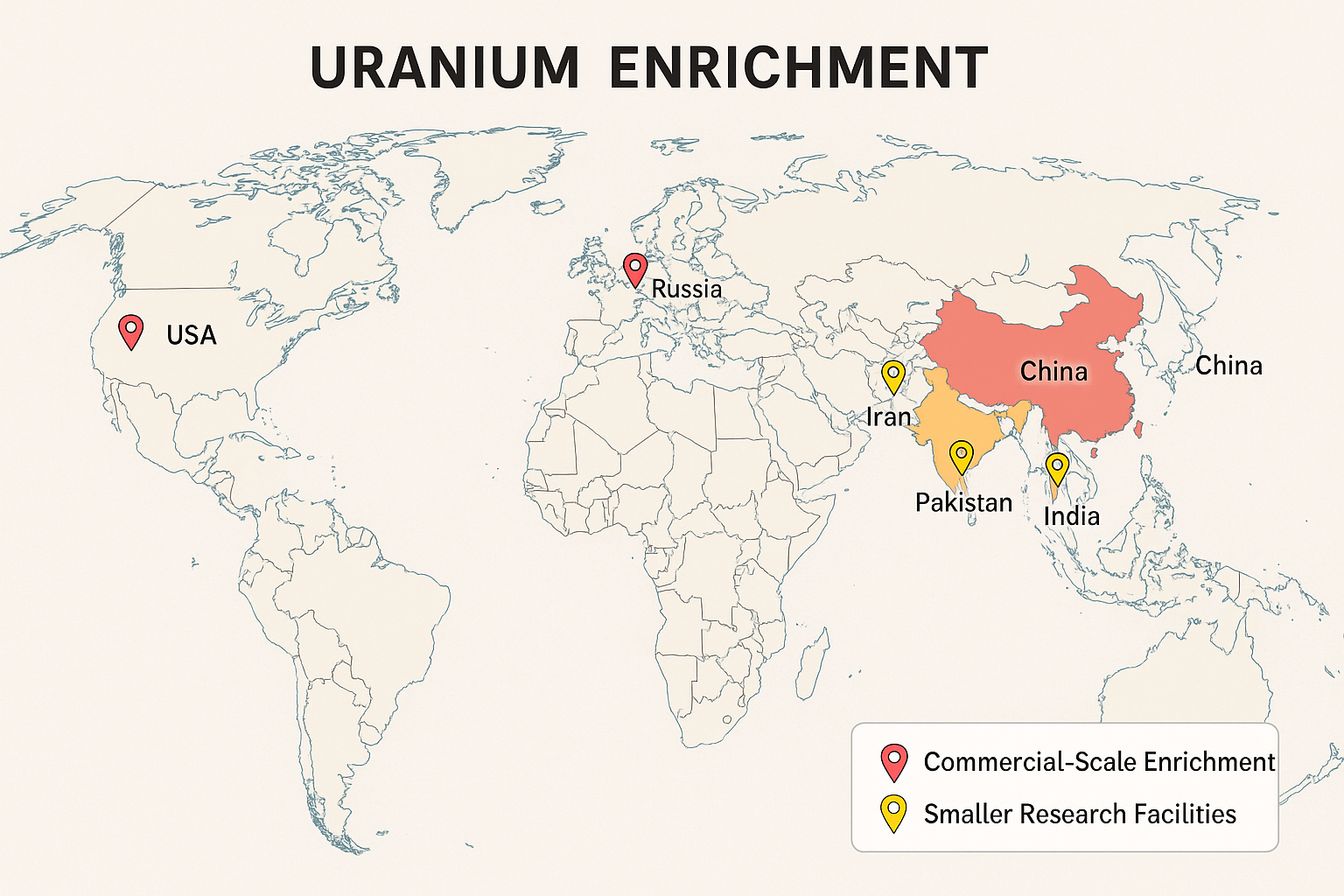
Global distribution of uranium enrichment facilities
The enrichment industry is dominated by four major companies: Rosatom (Russia), CNNC (China), Orano (France), and Urenco (UK/Netherlands/Germany) 2122. Together, these companies control most of the world’s enrichment capacity 2120.
International monitoring of enrichment facilities is conducted by the International Atomic Energy Agency (IAEA) to ensure peaceful use 2324. This oversight is crucial because the same technology used for civilian nuclear power can potentially be applied to weapons programs 2325.
Environmental and Safety Considerations
Uranium enrichment facilities must manage several environmental and safety challenges 2627. These include the proper handling of uranium hexafluoride, which reacts violently with water to form corrosive hydrogen fluoride 285.
Another major challenge is the management of depleted uranium, the byproduct of the enrichment process 2926. This material contains mostly U-238 and must be stored safely or repurposed for other applications 2930.
Modern enrichment facilities employ extensive safety measures and environmental monitoring to minimize risks 2831. These include multiple containment barriers, radiation monitoring, and emergency response procedures 2831.
Conclusion
Uranium enrichment represents a remarkable technological achievement that has made nuclear power possible 12. By concentrating the rare U-235 isotope, we can harness the enormous energy potential of uranium for electricity generation 52.
As enrichment technology continues to evolve, with more efficient methods like laser enrichment on the horizon, the process may become even more economical and environmentally friendly 1016. However, the dual-use nature of enrichment technology will continue to require careful international oversight 2324.
Understanding uranium enrichment is essential for comprehending both the opportunities and challenges of nuclear energy 25. As the world seeks carbon-free energy sources, enriched uranium will likely remain a significant part of the global energy mix 516.
Footnotes
-
https://www.centrusenergy.com/learn-more/uranium-enrichment/ ↩ ↩2 ↩3 ↩4 ↩5 ↩6 ↩7 ↩8 ↩9 ↩10 ↩11 ↩12
-
https://world-nuclear.org/information-library/nuclear-fuel-cycle/conversion-enrichment-and-fabrication/uranium-enrichment ↩ ↩2 ↩3 ↩4 ↩5 ↩6 ↩7 ↩8 ↩9 ↩10 ↩11 ↩12 ↩13 ↩14 ↩15 ↩16 ↩17 ↩18 ↩19 ↩20 ↩21 ↩22 ↩23 ↩24 ↩25 ↩26 ↩27
-
https://www.nrc.gov/materials/fuel-cycle-fac/ur-enrichment.html ↩ ↩2 ↩3 ↩4
-
https://www.centrusenergy.com/learn-more/nuclear-fuel-cycle/enrichment/ ↩ ↩2 ↩3 ↩4 ↩5 ↩6 ↩7 ↩8 ↩9 ↩10 ↩11 ↩12 ↩13 ↩14 ↩15
-
https://geoinfo.nmt.edu/resources/uranium/enrichment.html ↩ ↩2 ↩3 ↩4 ↩5
-
https://pediaa.com/difference-between-u-235-and-u-238/ ↩ ↩2 ↩3
-
https://visionias.in/current-affairs/upsc-daily-news-summary/article/2025-03-31/the-hindu/science-and-technology/centrifuge-getting-to-the-good-uranium ↩
-
https://www.numberanalytics.com/blog/ultimate-uranium-enrichment-guide ↩ ↩2 ↩3 ↩4 ↩5 ↩6 ↩7
-
https://energyeducation.ca/encyclopedia/Gas_centrifuge_for_uranium_enrichment ↩ ↩2 ↩3 ↩4
-
https://www.globalsecurity.org/wmd/intro/u-gaseous.htm ↩ ↩2 ↩3 ↩4 ↩5 ↩6 ↩7 ↩8 ↩9
-
https://www.scitechnol.com/download.php?download=peer-review-pdfs%2Flaser-enrichment-advancements-and-applications-in-uranium-processing-rFYg.pdf ↩ ↩2 ↩3 ↩4
-
https://tutorials.nti.org/nuclear-101/uranium-enrichment/ ↩ ↩2 ↩3 ↩4 ↩5 ↩6 ↩7
-
https://www.reddit.com/r/NuclearPower/comments/1ourgm/difference_between_low_enriched_uranium_and/ ↩ ↩2
-
https://www.verifiedmarketreports.com/blog/the-top-7-trends-shaping-the-enriched-uranium-market/ ↩ ↩2 ↩3 ↩4
-
https://www.world-nuclear-news.org/articles/rosatom-launches-reactor-tests-of-5-enriched-nuclear-fuel ↩
-
https://world-nuclear.org/information-library/nuclear-fuel-cycle/uranium-resources/military-warheads-as-a-source-of-nuclear-fuel ↩
-
https://fissilematerials.org/facilities/enrichment_plants.html ↩ ↩2 ↩3
-
https://thundersaidenergy.com/downloads/uranium-enrichment-by-country-by-company-by-facility/ ↩ ↩2 ↩3 ↩4
-
https://www.nsenergybusiness.com/analysis/top-uranium-producing-companies/ ↩
-
https://www.ungeneva.org/en/news-media/news/2025/06/107553/monitoring-iran-and-promoting-peaceful-use-nuclear-energy-iaeas-role ↩ ↩2 ↩3
-
http://resources.inmm.org/annual-meeting-proceedings/safeguards-approach-natural-uranium-conversion-plants ↩ ↩2
-
https://telanganatoday.com/whats-uranium-enrichment-how-is-it-used-for-nuclear-bombs ↩
-
https://www.iaea.org/sites/default/files/publications/magazines/bulletin/bull22-2/22204742329.pdf ↩ ↩2
-
https://foe.org/blog/is-nuclear-power-bad-for-the-environment/ ↩
-
https://www-pub.iaea.org/MTCD/Publications/PDF/PUB2038_web.pdf ↩ ↩2 ↩3